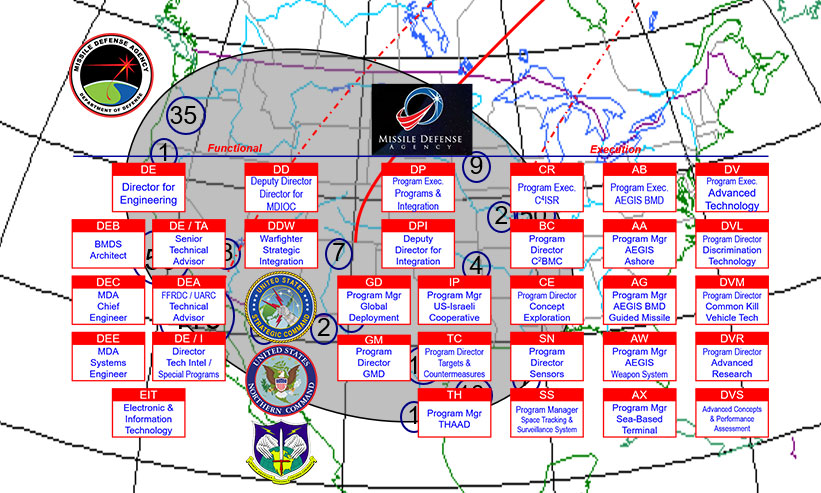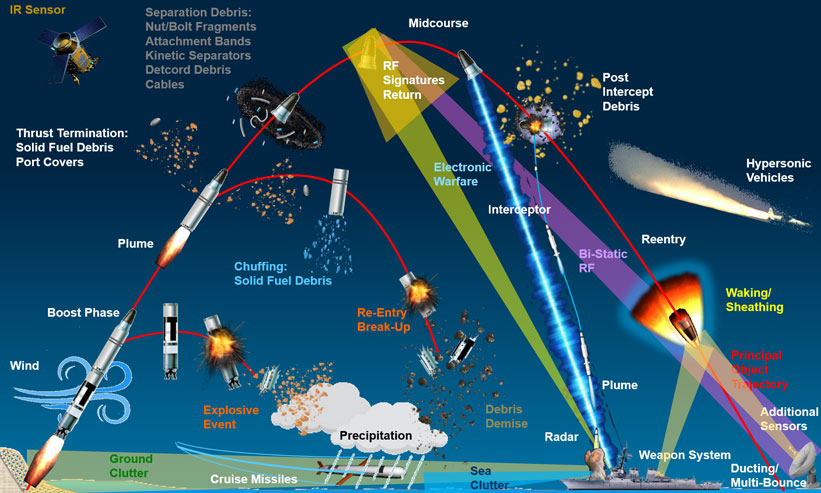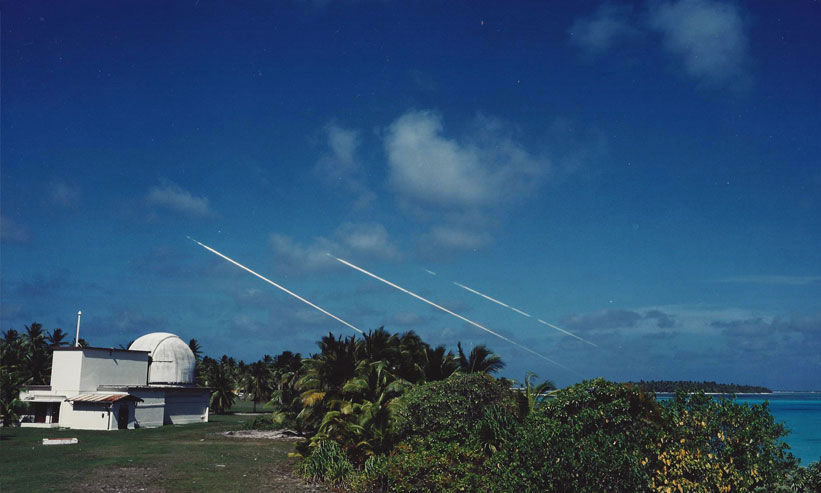- Member of the Shuttle Electrodynamic Tether System (SETS) Science Team.
- Member of the Student Explorer Demonstration Initiative (STEDI) satellite design team, modeled impact of solar conditions on satellite orbits over duration of proposed missions.
- Designed and instructed 100-level course: The Solar System and associated laboratory.
Ionospheric Studies
Physics & Chemistry of the Atmosphere
Developed series of hi-fidelity atmospheric models
- Stochastic algorithms mimic atmospheric dynamics that included gravity waves, turbulent eddies, etc.
- Clutter algorithm generated statistical variations in spatial structure of ambient atmosphere and aurora
- 4-D spatial/temporal model that generated deterministic component of aurora structure/activity.
- Temporal developments depend on magnetic field strengths and a comprehensive chemical reaction set that utilized more than 40,000 reactions
Exercised above algorithms to generate databases used in signal processing test and analysis of IR sensor packages onboard proposed DoD-Space Defense Initiative (SDI) remote sensing/acquisition platforms.
Nuclear Weapons Environment
Extended series of hi-fidelity atmospheric models
- Clutter algorithm generated statistical variations in spatial structure of ambient, aurora, and Nuclear Weapons environments.
- 4-D spatial/temporal model that generated deterministic component of nuclear fireball’s structure/activity.
Developed and expanded atmospheric models and closed reaction sets for DNA’s Project EXCEDE.
- Localized electron beam energies were consistent with beta patch energies following an ‘at altitude’ low yield nuclear detonation.
Global Thermo-Nuclear War
Ensure Missile System Electronics are still functional
- Missiles sit in silos for many, many months
- Can withstand an Electromagnetic Pulse
Ensure Silo can withstand proximal Nuclear Warhead detonation
Ensure Communications between Silo and Missile Alert Facility (MAF) will not be interrupted in event of a Nuclear Burst
Desert Storm
Designed / implemented air attrition data generation capability in support of Operation, providing per-sortie attrition databases for force-on-force allocation models.
Assessed US aircraft en route and terminal attrition rates as function of:
- Strike aircraft combinations;
- Strike package electronic countermeasures (ECM);
- Weapons load-outs;
- Penetrator airframe RADAR Cross-Section
- RED defensive counter-air CONOPS
- RED surface-to-air missile (SAM) sstem deployment strategies;
- RED SAM EW and FC sensor capabilities;
- RED interceptor performance.
Analyses performed addressed:
- SAM performance in variety of ECM environments including: signature reduction; stand-in, stand-off jamming; escort jamming [with and without synchronized blinking]; self-screen deceptive jamming; and decoy deployment.
- mSAM area defense capabilities against cruise missiles.
- mAircraft vulnerability to SAM HE warhead fragments.

Fire Control
- Manage Track Data to determine viable Launch Window
- Project optimal Predicted Intercept Point[s] supported by Guidance, Navigation and Control
- Effectively solve the Bullet-to-Bullet Solution
Global Battle Management
Optimize Resources across multiple Sensors and Launch Locations that will ensure:
- Detection / Acquisition of Threat
- Accurately Project Tracks of acquired Threat Complexes
- Discriminate / ID Lethal Object from Decoys
- Ensure Intercept Geometry supports Energy Transfer sufficient to guarantee kill of Lethal Object

Powerful Processors of Today
Optimize Resources across multiple Sensors and Launch Locations that will ensure:
- Detection / Acquisition of Threat
- Accurately Project Tracks of acquired Threat Complexes
- Discriminate / ID Lethal Object from Decoys
- Ensure Intercept Geometry supports Energy Transfer sufficient to guarantee kill of Lethal Object
Ionospheric Studies
- Member of the Shuttle Electrodynamic Tether System (SETS) Science Team.
- Member of the Student Explorer Demonstration Initiative (STEDI) satellite design team, modeled impact of solar conditions on satellite orbits over duration of proposed missions.
- Designed and instructed 100-level course: The Solar System and associated laboratory.
Physics & Chemistry of the Atmosphere
Developed series of hi-fidelity atmospheric models
- Stochastic algorithms mimic atmospheric dynamics that included gravity waves, turbulent eddies, etc.
- Clutter algorithm generated statistical variations in spatial structure of ambient atmosphere and aurora
- 4-D spatial/temporal model that generated deterministic component of aurora structure/activity.
- Temporal developments depend on magnetic field strengths and a comprehensive chemical reaction set that utilized more than 40,000 reactions
Exercised above algorithms to generate databases used in signal processing test and analysis of IR sensor packages onboard proposed DoD-Space Defense Initiative (SDI) remote sensing/acquisition platforms.
Nuclear Weapons Environment
Extended series of hi-fidelity atmospheric models
- Clutter algorithm generated statistical variations in spatial structure of ambient, aurora, and Nuclear Weapons environments.
- 4-D spatial/temporal model that generated deterministic component of nuclear fireball’s structure/activity.
Developed and expanded atmospheric models and closed reaction sets for DNA’s Project EXCEDE.
- Localized electron beam energies were consistent with beta patch energies following an ‘at altitude’ low yield nuclear detonation.
Global Thermo-Nuclear War
Ensure Missile System Electronics are still functional
- Missiles sit in silos for many, many months
- Can withstand an Electromagnetic Pulse
Ensure Silo can withstand proximal Nuclear Warhead detonation
Ensure Communications between Silo and Missile Alert Facility (MAF) will not be interrupted in event of a Nuclear Burst
Desert Storm
Designed / implemented air attrition data generation capability in support of Operation, providing per-sortie attrition databases for force-on-force allocation models.
Assessed US aircraft en route and terminal attrition rates as function of:
- Strike aircraft combinations;
- Strike package electronic countermeasures (ECM);
- Weapons load-outs;
- Penetrator airframe RADAR Cross-Section
- RED defensive counter-air CONOPS
- RED surface-to-air missile (SAM) sstem deployment strategies;
- RED SAM EW and FC sensor capabilities;
- RED interceptor performance.
Analyses performed addressed:
- SAM performance in variety of ECM environments including: signature reduction; stand-in, stand-off jamming; escort jamming [with and without synchronized blinking]; self-screen deceptive jamming; and decoy deployment.
- mSAM area defense capabilities against cruise missiles.
- mAircraft vulnerability to SAM HE warhead fragments.

Fire Control
- Manage Track Data to determine viable Launch Window
- Project optimal Predicted Intercept Point[s] supported by Guidance, Navigation and Control
- Effectively solve the Bullet-to-Bullet Solution
Global Battle Management
Optimize Resources across multiple Sensors and Launch Locations that will ensure:
- Detection / Acquisition of Threat
- Accurately Project Tracks of acquired Threat Complexes
- Discriminate / ID Lethal Object from Decoys
- Ensure Intercept Geometry supports Energy Transfer sufficient to guarantee kill of Lethal Object

Powerful Processors of Today
Optimize Resources across multiple Sensors and Launch Locations that will ensure:
- Detection / Acquisition of Threat
- Accurately Project Tracks of acquired Threat Complexes
- Discriminate / ID Lethal Object from Decoys
- Ensure Intercept Geometry supports Energy Transfer sufficient to guarantee kill of Lethal Object




